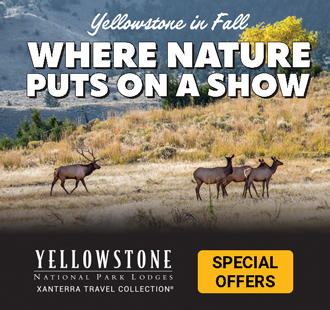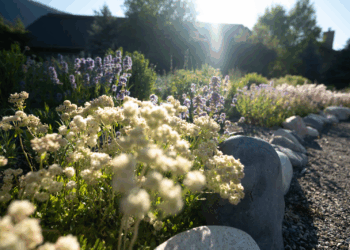CENTER FOR LARGE LANDSCAPE CONSERVATION
Wildlife crossings—including vegetation-covered overpasses spanning a highway and their less-apparent underpass cousins—are becoming more familiar in the West. The “Animals’ Bridge” over Montana Highway 93 on the Flathead Reservation and dozens of underpasses along the same route are Montana’s best-known examples. In the coming years, U.S. Highway 191 south of Gallatin Gateway may get its first series of wildlife crossings. With levels of traffic from 10,000-16,000 vehicles per day, over 24% of crashes on 191 are with wildlife and the highway poses a barrier to animals attempting to access key habitats.
Should an application recently submitted to the Federal Highway Administration by the Montana Department of Transportation prove successful, 191 may gain a new wildlife overpass, upgrades to an existing underpass, and a bridge retrofit providing a pathway for wildlife below. The series of crossing structures would be combined with fencing to funnel wildlife to safe crossing opportunities.
Wildlife crossing structures in combination with fencing, if located and designed correctly, can reduce wildlife-vehicle collisions by 85% or more. But how are the locations and types of structures determined? Bridging biology and engineering, scientists and engineers collaborate to determine which structures will be effective and where and how to build them.
Shannon Crossen, senior biologist at Jacobs—a consulting firm engaged by the Bozeman-based Center for Large Landscape Conservation to carry out an engineering feasibility study for the potential crossings—described key factors in location and design of wildlife crossings.
“In combination with extensive analyses of wildlife movement, traffic, and land use conducted by CLLC and Jacobs, we also reviewed multiple factors that influence the siting and design of wildlife crossing structures,” Crossen said. “For this US-191 overpass, factors included location of conservation easements, current and future developments, proximity to regulated floodplains, target species needs and movement patterns, future highway improvements and terrain.”
While elk and deer are the primary target species for the crossings, as they are most frequently hit by vehicles in this area, Crossen said the structures are designed to maximize the number of species that could benefit from the safe passage opportunities.
“Siting within protected habitat and away from floodplains and designing for multiple species maximizes the lifespan of the crossing structure and its ecological value. Our design takes into account transportation needs while also addressing the need to reduce wildlife-vehicle collisions and maintain habitat connectivity,” Crossen explained.
“Planning and designing wildlife crossings is a highly interdisciplinary and collaborative process,” Crossen said. “Our team includes biologists, environmental planners, and engineers spanning transportation, hydraulics, geotechnical, structural and construction, as well as other technical specialties who worked closely with each other and CLLC on all aspects of the project.”
Crossen said that while the team was conducting the field review for the engineering feasibility study, Jacobs transportation engineer David Baker located a stock pass in the project vicinity that the team was not initially aware of.
“Upon further inspection, we determined this was an opportunity to integrate an additional crossing about 700 feet south of the proposed overpass,” Crossen said. “This stock pass could not accommodate elk passage but could support many other species by upsizing it with little additional cost, effort, or roadway impacts to the project.”
Crossen explained that having multiple types of crossings allows the project to provide diverse species passage opportunities and bring the best available research and practice to the project design, maximizing habitat connectivity in the project area.
The engineering feasibility study was made possible by donations from community partners, and the application MDT submitted is based on its results. If the application succeeds, the Wildlife Crossings Pilot Program, a discretionary program of the FHWA, will pay for over 80% of the cost of the $26 million project. One of the requirements of the highly competitive WCPP is a non-federal match. CLLC has secured pledges from businesses, nonprofits, foundations and private donors, and is continuing to fundraise to achieve the $3.5 million required.
Prior to the engineering feasibility study, CLLC and Montana State University’s Western Transportation Institute—in consultation with public agency personnel—identified the area from Gallatin Gateway to Spanish Creek as the top priority of 11 potential sites for measures to accommodate habitat connectivity. This was based on an in-depth examination of motorist safety, wildlife movement, and habitat in a 191/MT 64 Wildlife and Transportation Assessment.
“The Assessment showed where actions are most needed to reduce wildlife-vehicle collisions and maintain or improve wildlife’s ability to move across the road to access important resources and habitat,” said CLLC road ecologist Liz Fairbank, who was the lead author of the assessment.
While crossing structures require upfront investment, given their 75-year lifespan, they often pay for themselves well ahead of schedule due to the cost savings of fewer wildlife-vehicle collisions. Based on a 2020 corridor study by MDT, the estimated cost of injuries and property damage related to these accidents between Four Corners and Beaver Creek is $27 million over 10 years.
“In situations like this, building wildlife crossings can actually cost less over the life of the project than doing nothing to fix the problem,” said Fairbank.
Wildlife Crossings Pilot Program awards are expected to be announced in early 2025. If the 191 application is successful, a planning process for construction should commence in 2026.
Updates on the 191 Wildlife Crossings Project will be posted on CLLC’s website at largelandscapes.org/191.














